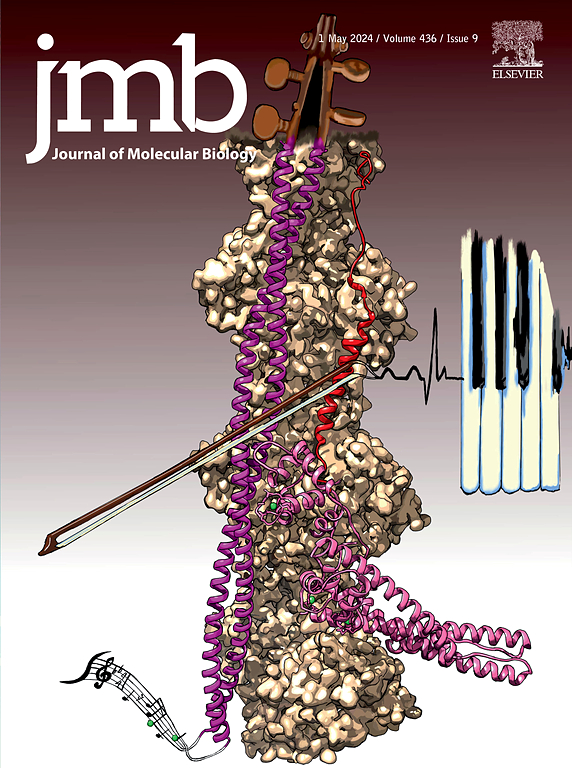硫胺焦磷酸核糖开关受大肠杆菌赖氨酸衍生代谢转化产物的影响。
IF 4.5
2区 生物学
Q1 BIOCHEMISTRY & MOLECULAR BIOLOGY
引用次数: 0
摘要
核糖开关是通过特异性监测细胞代谢物来控制基因表达的5'非翻译调节因子。与核蛋白开关结合的代谢物在转录或翻译水平上触发遗传调控。核糖开关通常对非同源代谢物表现出高度亲和和强烈的歧视,使其非常适合调节基因表达。重要的是,尽管已经很好地描述了确保细菌代谢转化和再循环的细胞过程,但关于这些过程如何影响核糖开关调节机制的信息很少。在这里,我们描述了大肠杆菌中赖氨酸和焦磷酸硫胺(TPP)感应核开关的调节机制。与之前的结果一致,我们的研究表明,在生长培养基中添加赖氨酸或TPP可显著降低各自的核糖体开关调节mrna的表达。令人惊讶的是,我们发现赖氨酸的加入也会导致TPP调控的mrna显著减少,这表明赖氨酸间接影响TPP的核开关。利用Keio收集的突变菌株,我们观察到赖氨酸对TPP核开关的影响在干扰赖氨酸降解过程时消失。这些数据表明赖氨酸降解产物可能通过代谢转化产生TPP。相反,我们的研究结果表明TPP不调节赖氨酸核糖体开关的调节,这表明TPP不会间接影响赖氨酸核糖体开关的遗传控制。总之,我们的研究结果表明,胞内赖氨酸浓度的变化可以通过TPP核开关检测到,从而表明核开关可能对细胞应激敏感,而与它们的同源代谢物没有直接关系。本文章由计算机程序翻译,如有差异,请以英文原文为准。

The Thiamin Pyrophosphate Riboswitch is Affected by Lysine-derived Metabolic Conversion Products in Escherichia coli
Riboswitches are 5′ untranslated regulators that control gene expression by specifically monitoring cellular metabolites. Metabolite binding to the riboswitch triggers the genetic regulation at the transcriptional or translational level. Riboswitches typically exhibit high affinities and strong discrimination against non-cognate metabolites, making them well suited to regulate gene expression. Importantly, despite the well characterized cellular processes ensuring metabolic conversion and recycling in bacteria, there is little information about how these processes influence riboswitch regulation mechanisms. Here, we characterize the regulation mechanisms of the lysine-sensing and thiamin pyrophosphate (TPP)-sensing riboswitches in E. coli. In agreement with previous results, our study indicates that the addition of lysine or TPP to the growth medium significantly reduces the expression of the respective riboswitch-regulated mRNAs. Surprisingly, we find that the addition of lysine also leads to a significant decrease in TPP-regulated mRNAs, suggesting that lysine indirectly affects TPP riboswitches. Using mutant strains from the Keio collection, we observe that the effect of lysine on TPP riboswitches is lost when perturbing the lysine degradation process. These data suggest that lysine degradation products may be used to generate TPP through metabolic conversion. In contrast, our results indicate that TPP does not modulate the regulation of the lysine riboswitch, suggesting that TPP does not indirectly affect the lysine riboswitch genetic control. Together, our results indicate that intracellular changes in lysine concentrations can be detected by TPP riboswitches, thus suggesting that riboswitches may be sensitive to cellular stress that are not directly related to their cognate metabolite.
求助全文
通过发布文献求助,成功后即可免费获取论文全文。
去求助
来源期刊

Journal of Molecular Biology
生物-生化与分子生物学
CiteScore
11.30
自引率
1.80%
发文量
412
审稿时长
28 days
期刊介绍:
Journal of Molecular Biology (JMB) provides high quality, comprehensive and broad coverage in all areas of molecular biology. The journal publishes original scientific research papers that provide mechanistic and functional insights and report a significant advance to the field. The journal encourages the submission of multidisciplinary studies that use complementary experimental and computational approaches to address challenging biological questions.
Research areas include but are not limited to: Biomolecular interactions, signaling networks, systems biology; Cell cycle, cell growth, cell differentiation; Cell death, autophagy; Cell signaling and regulation; Chemical biology; Computational biology, in combination with experimental studies; DNA replication, repair, and recombination; Development, regenerative biology, mechanistic and functional studies of stem cells; Epigenetics, chromatin structure and function; Gene expression; Membrane processes, cell surface proteins and cell-cell interactions; Methodological advances, both experimental and theoretical, including databases; Microbiology, virology, and interactions with the host or environment; Microbiota mechanistic and functional studies; Nuclear organization; Post-translational modifications, proteomics; Processing and function of biologically important macromolecules and complexes; Molecular basis of disease; RNA processing, structure and functions of non-coding RNAs, transcription; Sorting, spatiotemporal organization, trafficking; Structural biology; Synthetic biology; Translation, protein folding, chaperones, protein degradation and quality control.
 求助内容:
求助内容: 应助结果提醒方式:
应助结果提醒方式:


